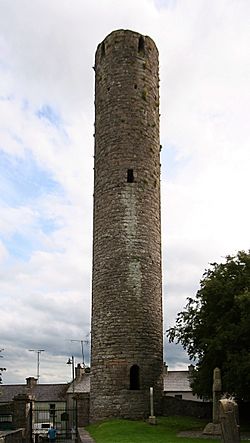Abbey of Kells facts for kids
| Mainistir Cheanannais | |

Round tower at Kells
|
|
| Monastery information | |
|---|---|
| Established | 6th century/early 9th century |
| Disestablished | 12th century |
| People | |
| Founder(s) | Columba/Cellach of Iona |
| Site | |
| Location | Kells, County Meath, Ireland |
| Coordinates | 53°43′38″N 6°52′48″W / 53.72722°N 6.88000°W |
| Designations | |
|---|---|
| Official name | Kells (round tower & High Crosses) |
| Reference no. | 158 |
The Abbey of Kells (called Mainistir Cheanannais in Irish) is an old monastery in Kells, County Meath, Ireland. It is about 64 kilometers (40 miles) north of Dublin. This important place was started in the early 800s. For many years, the famous Book of Kells was kept safe here. It stayed at the abbey until the 1650s.
Historians are not sure exactly when or where the Book of Kells was made. But it is believed that much of it might have been created at this abbey.
Contents
History of Kells Abbey
How the Abbey Started
The Abbey of Kells was first founded around 554 AD. It is said that Saint Columba started it. He received the land from the High King Diarmuid Mac Caroll of Tara.
The abbey was later rebuilt starting in 807 AD. The church was officially opened in 814 AD. This new abbey was built on the site of an old Irish hill fort.
Iona and Kells Abbey
In 814, Cellach, who was the Abbot of Iona, moved to Kells. Iona was another important monastery. Even though Cellach moved, Iona remained the main center for monks following Saint Columba for many years. This was despite the dangers of Viking raids.
In 878, important holy items, including Saint Columba's special container for relics, were moved to Ireland. Kells then became the new main center for the Columban monks. It is thought that the Book of Kells might have been brought to Kells at this time.
The Famous Book of Kells
The Book of Kells is a very famous illuminated manuscript. It is a beautifully decorated book of the four Gospels. There are different ideas about where it was made. Some believe it was started in Iona and finished in Kells. Others think it was written entirely in Kells by different monks over time. What we know for sure is that it was kept at Kells Abbey. Most people believe it was brought there from Iona.
Viking Raids and the Book
During the 900s, Vikings often attacked the abbey. They raided and stole from it many times. But even with these constant attacks, the monks managed to keep the Book of Kells safe.
In 1006, the Book of Kells was stolen from its shrine. A record from the Annals of Ulster (old Irish historical notes) is thought to be about this theft. It says the book was returned after two months, but its cover was missing. The missing cover likely explains why some illustrations at the beginning and end of the book are gone.
The Book's Journey After the Abbey
The Book of Kells stayed at the abbey for the rest of the Middle Ages. In the 1100s, details about the abbey's land deals were copied onto blank pages of the book. This was a common practice back then. This is the first clear proof that the book was at the abbey.
Later in the same century, the monastery was closed down. The abbey church became a regular parish church. The Book of Kells continued to be kept there. Catholic landowners then took over the land.
The Book of Kells remained at Kells until the 1650s. At that time, Cromwell's soldiers were in the town. For safety, the book was sent to Dublin. In 1661, the Book of Kells ended up at Trinity College, Dublin. It has been kept there ever since.
What You Can See Today
Today, the old monastery site has several interesting things to see.
The Round Tower
There is a tall round tower from the 900s. It stands about 27 meters (90 feet) high from the original ground level. This tower is special because it has five windows on its top floor. Most round towers only have four. These five windows look out over the five roads that lead into Kells.
The Church Building
The church building you see today belongs to the Church of Ireland. It was built in 1778 and was updated in 1965.
Other Important Structures
Nearby, you can find St. Columb's House. This is a small chapel from the 900s. There are also several high crosses from the 800s and 900s. Three crosses and a cross base are on the abbey site itself.
The "Market Cross" is another old cross from the 800s. It was once at the abbey's eastern gate. Now, it stands in front of the old courthouse. A story says that Cromwell's soldiers damaged it. It is also said that it was used to hang people who took part in the 1798 rebellion.
The round tower and the high crosses are recognized as a National Monument of Ireland. The old monastery site is open for everyone to visit.
See also
 In Spanish: Abadía de Kells para niños
In Spanish: Abadía de Kells para niños


